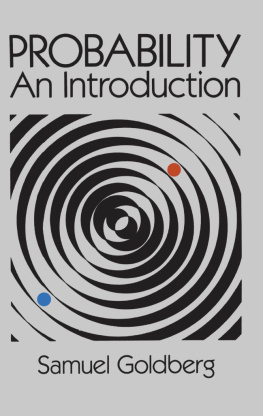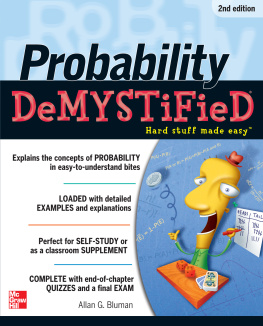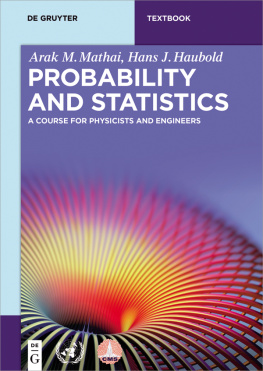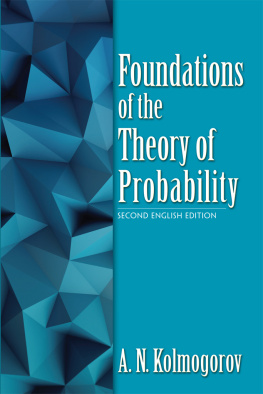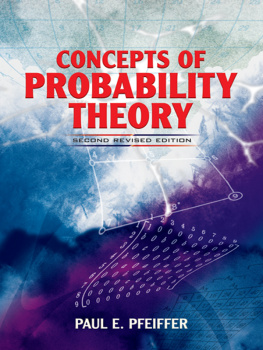PROBABILITY
An Introduction
PROBABILITY
An Introduction
SAMUEL GOLDBERG
Emeritus Professor of Mathematics,
Oberlin College
Dover Publications, Inc.
New York
Copyright 1960 by Samuel Goldberg.
All rights reserved
This Dover edition, first published in 1986, is an unabridged republication of the work first published in 1960 by Prentice-Hall, Inc., Englewood Cliffs, N.J.
Library of Congress Cataloging-In-Publication Data
Goldberg, Samuel, 1925
Probability: an introduction.
Reprint. Originally published: Englewood Cliffs, N.J. : Prentice-Hall, 1960. (Prentice-Hall mathematics series)
Includes index.
1. Probabilities. I. Title. II. Series: Prentice-Hall mathematics series.
QA273.G62 1987 519.2 86-24067
ISBN-13: 978-0-486-65252-8
ISBN-10: 0-486-65252-1
Manufactured in the United States by Courier Corporation
65252110
www.doverpublications.com
PREFACE

T HIS BOOK is intended for all who require a mathematically sound, but elementary introduction to the theory of probability.
Probability concepts are now of great importance in a wide variety of fields. The theory of probability, as the foundation upon which the methods of statistics are based, should command the attention of those who want to understand as well as apply statistical techniques. Probabilistic theories, making explicit reference to the nature and effects of chance phenomena, are the rule rather than the exception in the physical and biological sciences. Less well known is the fact that probability concepts are finding increased use in the social sciences and business: psychologists develop stochastic models for learning; economists use the techniques of game theory to discuss competition and markets; expected values, variances, and other matters related to random variables turn out to be important in the problem of finding combinations of securities that best meet the needs of the investor; business managers, because their decisions must be made in the face of uncertainty, invoke the theory of probability as an aid in planning inventory, establishing quality control, designing market surveys, etc. We need not go onit is clear that probability concepts and methods are now widely used and will see even more extensive use in the future.
One noteworthy indication of the importance of our subject is the recent decision of the Commission on Mathematics of the College Entrance Examination Board to recommend that a course in probability and statistical inference be offered in the twelfth grade of the secondary school. Thus, secondary school teachers of mathematics, at some point in their college or in-service training, or in summer institutes (such as those sponsored by the National Science Foundation), should achieve some mastery of the elements of probability theory. Parts of this book were used in courses offered in NSF Institutes held at Oberlin College in 1958 and 1959, and the final manuscript has benefited from the helpful comments of the many teachers who studied preliminary versions.
Although there are a number of excellent textbooks on probability, they are all written for readers who have the mathematical sophistication that comes with a working knowledge of the differential and integral calculus. It seemed to me worthwhile to bring the theory of probability to the attention of those who do not have the calculus prerequisite. It was with this aim in mind that I limited myself to those topics that are accessible to readers with only a good background in high school algebra and a little ability in the reading and manipulation of mathematical symbols. The consequent limitation to finite sample spaces, although severe, facilitates a careful logical treatment of the essentials needed by all who use probability concepts. Furthermore, I have found that an understanding of the basic definitions, theorems, and methods in the finite case makes it much easier for students with the necessary preparation to master the corresponding ideas in the infinite case. I am therefore hopeful that this volume, although written as a basic textbook for courses in probability and statistics for students without calculus, will also prove useful in courses for those who have previous training in calculus.
One further possible use of this book is worthy of mention here. There are many college students who, for one reason or another, can take at most one year of mathematics. These students are often offered a smorgasbord survey course in which they sample one topic after another and learn very little about lots of things. Many teachers, however, prefer to offer a course centering on a few main topics, going into each systematically and deeply enough to give the student a reasonable depth of knowledge in the chosen subjects. Although many topics vie for inclusion in such a program, I believe a strong case can be made for a course that concentrates on sets and probability in the finite case at first, proceeds to an introduction to the calculus, and then applies this calculus to the elements of probability in the infinite case. (In my own course, I also include applications of the differential calculus to simple problems in economics.) Such a course, if properly executed, can give the student a keen sense of the nature and achievements of mathematical thinking, while laying a firm foundation for further study in economics, statistics, operations research, or allied fields. Such a program would therefore be especially valuable for social science and business students, assuming they can devote only a year to mathematics at the college level. I have used this volume in preliminary form in roughly the first third of such a year course at Oberlin College, with students who present less than three years of high school mathematics for entrance. Teachers who share my point of view may also find this book useful in their own introductory mathematics courses.
Since the theory of probability is best formulated using the language and notation of sets, we devote the first chapter to the elementary mathematics of sets. Proofs of laws in the algebra of sets are simplified by the use of so-called membership tables, a device analagous to truth tables in logic. Here we also introduce Cartesian product sets, which are needed at many points throughout the book.
, offer a set of exercises in which the previously mastered probability theory is applied to a wide variety of situations requiring the use of sophisticated counting techniques. It has been our experience that this procedure makes it considerably easier for the student to learn this basic material.
sample spaces, and probability distributions, means, standard deviations, joint probability functions, covariance, and correlation are discussed. Independence of random variables is defined and, with these ideas extended to the multivariate case, applications to random sampling theory can be included. The sampling distribution of the sample mean is discussed and formulas for its mean and variance are derived for both sampling with and without replacement.
The most important probability function defined on a finite sample space, the binomial distribution, forms the subject matter of the final chapter. The basic properties of a Bernoulli process and a binomially distributed random variable are derived, and the use of tables of cumulative binomial probabilities is discussed. Applications to the testing of statistical hypotheses (significance tests), as well as to a more complex problem of decision-making under uncertainty serve to illustrate how probability methods are applied in statistical investigations.
For some classes, teachers may find it necessary to offer supplementary lessons on the method of mathematical induction and the use of summation signs, as these topics arise in the text. I have also found that it is wise to constantly remind the beginning student of the substitution principle, for example, that from Var(
Next page
